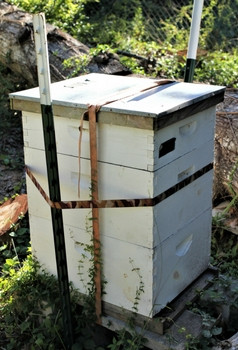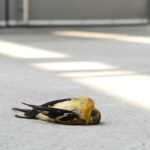Spring rain, while essential for nature’s rejuvenation, can bring concerns for beekeepers. A common question among both novice and experienced beekeepers is: “Do Bees Fly In Rain?” The answer isn’t always straightforward, and understanding bee behavior in rainy conditions is crucial for responsible beekeeping.
Can Bees Fly in Rain? The Short Answer
Yes, bees are technically capable of flying in the rain, but it’s far from ideal and something they actively avoid. While these industrious insects are well-adapted to various weather conditions, rain presents significant challenges to their flight and overall well-being. Think of it like humans walking in a downpour – possible, but definitely not preferred.
Why Rain is Dangerous for Bees
Several factors make flying in the rain hazardous for bees:
- Water Accumulation: Even light rain or mist can be problematic. Water droplets can accumulate on a bee’s fuzzy body and wings. This added weight is significant for such small creatures and interferes with their flight mechanics. Imagine trying to fly with tiny weights attached to your arms – it’s much harder work!
- Impeded Wing Beats: Bees’ wings beat incredibly fast, around 12,000 times per minute, to generate lift. Water clinging to their wings disrupts this rapid motion, making flight less efficient and more energy-consuming. It’s like trying to run with wet, heavy clothes.
- Raindrop Impact: Heavy rain with large droplets poses a direct physical threat. A large raindrop can hit a bee with considerable force, potentially knocking it out of the sky or even causing injury. This is akin to being pelted with small projectiles while flying.
- Hypothermia Risk: Bees are cold-blooded insects, and getting wet in cool rainy weather can lead to a rapid drop in body temperature. This hypothermia can immobilize them, making it impossible to fly back to the hive and potentially leading to death.
 Beehive secured with bricks on top to prevent lid from blowing off during a storm.
Beehive secured with bricks on top to prevent lid from blowing off during a storm.
Bee Behavior Before and During Storms
Bees are remarkably attuned to changes in their environment and exhibit specific behaviors when inclement weather approaches:
- Propolis Fortification: Bees instinctively prepare their hives for storms. They use propolis, a resinous substance they collect from trees, to seal cracks and crevices in the hive. This natural “glue” strengthens the hive structure, making it more resistant to wind and rain penetration. New hives, lacking this thorough sealing, are more vulnerable.
- Reduced Foraging Activity: As a storm nears, you’ll notice a decrease in bee activity around the hive entrance. Forager bees, those responsible for collecting nectar and pollen, sense the change in atmospheric pressure and humidity and stay inside. Bees already out foraging will quickly return to the hive, and you’ll observe a cessation of bees leaving.
- Hive Duty Reassignment: With more bees inside and fewer foragers venturing out, the hive’s priorities shift. Foragers often transition to tasks within the hive, such as regulating humidity and temperature. Maintaining optimal hive conditions becomes paramount during prolonged periods of rain.
- Food Supply Monitoring: Extended rainy periods can disrupt bees’ ability to forage. If rain persists for days or weeks, especially following honey harvest, beekeepers should check the hive’s food stores. Low food supplies may necessitate supplemental feeding, such as bee fondant, to ensure the colony doesn’t starve. This is especially important in spring when the colony is building up its population and resources.
How Beekeepers Can Help Bees Weather Storms
While bees are naturally resilient, beekeepers can take proactive steps to assist their colonies during storms:
- Secure the Hive Structure: A primary concern during storms is hive stability. A full hive laden with honey is heavy and less likely to topple, which is beneficial. However, strong winds can still pose a threat, especially to the hive cover.
- Weight the Lid: Placing bricks or heavy stones on top of the hive cover is a simple yet effective way to prevent it from being blown off by wind gusts, keeping rain out of the hive.
- Strapping for High-Risk Areas: In regions prone to hurricanes or tornadoes, more robust securing methods are necessary. Strapping hives together and anchoring them to T-posts driven into the ground provides significant stability against strong winds.
 Beehive strapped to t-posts for enhanced stability during strong storms like hurricanes or tornadoes.
Beehive strapped to t-posts for enhanced stability during strong storms like hurricanes or tornadoes.
- Consider Hive Placement: If possible, positioning hives near a sturdy structure like a barn or house can offer some wind protection. Turning the hive’s back to the prevailing wind direction can reduce wind impact. If moving the hive, keep it within a few feet of its original location to allow returning foragers to find their way back.
- Supplemental Feeding When Necessary: In prolonged rainy spells, monitor the hive’s honey stores. If food is running low, provide supplemental feed like bee fondant or syrup. However, avoid overfeeding; remove supplemental food once bees can forage naturally again.
- Observe and Adapt: Effective beekeeping is about observation and responsiveness. Pay attention to weather forecasts and bee behavior. For typical spring showers, bees are usually capable of managing. However, for severe storms, proactive intervention by the beekeeper can significantly enhance the colony’s safety and survival.
By understanding whether bees fly in the rain and taking appropriate measures, beekeepers can help their colonies thrive, rain or shine. Being a responsible beekeeper means being attuned to your bees’ needs and the environmental conditions they face.
